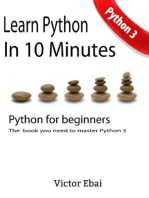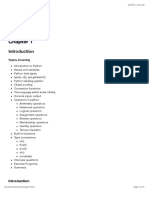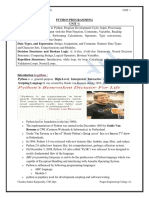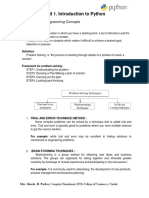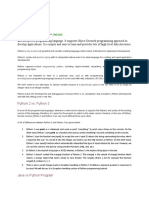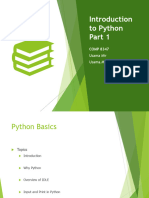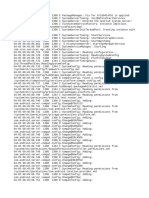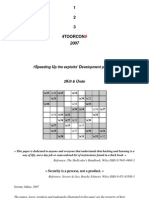Chapter 1 Introduction
Chapter 1 Introduction
Uploaded by
DURGA PRASAD TEKUCopyright:
Available Formats
Chapter 1 Introduction
Chapter 1 Introduction
Uploaded by
DURGA PRASAD TEKUCopyright
Available Formats
Share this document
Did you find this document useful?
Is this content inappropriate?
Copyright:
Available Formats
Chapter 1 Introduction
Chapter 1 Introduction
Uploaded by
DURGA PRASAD TEKUCopyright:
Available Formats
25/04/2019 Chapter 1 Introduction
Python Programming
by Narendra Allam
Copyright 2019
Chapter 1
Introduction
Topics Covering
Introduction to Python
Values and variables
Python data types
type(), id(), sys.getsizeof()
Python labeling system
Object pooling
Conversion functions
The language which knew infinity
Console input, output
Operators in python
Built-in functions
Type conversions
Exercise Programs
Introduction
There are 5000+ programming langauges in the world and we are still counting... Python is in the top 5
programming langauges as of 2019. Java, C, C++ and C# are other langauges in the top 5.
Python developed by Guido Van Rossum in 1989, and came into the programming world in 1991.
Python came into software industry as a scripting language.. PERL and Bash were other alternatives for
scripting by that time.
Scripting languages are mainly used for automation.
Later python was widely adopted in the research community and became a complete programming
language with robust futures like object orientation and functional programming. Having machine learning and
data analysis packages, Python has extensive support for research.
Why should I learn Python ?
Python is one of the top 5 languages(among 5000+ programming languages).
Python is heavily funded by Google..
There are more career paths after learning Python, one can choose his career path as,
a web developer
a data scientist
dev.weaving.io:8889/notebooks/VASU/updated Python Notebooks-final/Chapter 1 Introduction.ipynb 1/27
25/04/2019 Chapter 1 Introduction
a devops engineer
a server side programmer
etc..
Python features
1. High-level programming language
High-level programming languages are close to business problems. . whereas low-level programming
languages are close to system's problems..
Examples of Business problems are writing banking software, building an ecommerce website etc., Examples
of system problems are writing a device driver, memory manager, anti-virus, etc.
Example:- High-level programming languages: Python, Java, c#, Rube etc..
Low-level Programming languages: C, Assembly programming langu
ages etc..
2. Interpreted
Python is interpreted programming language. Code which is written in English, has to be translated to binary
code and understood by a computer. This is the process of translation.
There are two types of translations
1. Compilation.
2. Interpretation.
In compilation a compiler translates all the lines of code at the same time then starts the execution first line of
code.
In interpretation an interpreter takes the first line, translates to machine code and executes, then takes the
second line and so on.
3. Multi-purpose
Python can be used for developing multiple application types.
Web Applications using django, flask
Data analysis using pandas, numpy, matplotlib
Devops Automation using boto
IoT apps using raspberry pi API
Deeplearning using google's Tensorflow API, PyTorch, thaenos etc
4. Not just a scripting language
Python is a general purpose language. One can use python as a scripting language or as a programming
language, the puspose for which we use is different. In automation field, python programming is called as
scripting. And in application development side, it is called programming. In both cases, a single set of python
keywords and constructs are used. As a computer language there is no difference between scripting and
Programming in python.
Note:
The biggest difference is, Programming requires designing whihc is not necessary for scripting As we design,
programs are maintained for longer time, where as scripts are short-lived and use and throw code files.
dev.weaving.io:8889/notebooks/VASU/updated Python Notebooks-final/Chapter 1 Introduction.ipynb 2/27
25/04/2019 Chapter 1 Introduction
5. Extensible
High-level languages are not performant, because they are more focused to provide developer friendly
environment than optimizing for speed.
In real-time and time-critical applications, when performance required, we still have to consider languages
with low-level features, like C and C++. Python provides futures required to merge other programming
languages with python code. Java code can be used in python using 'jython', C# code can be accessed using
'IronPython'.
6. Multi paradigm
Python welcomes programmers from various backgrounds, as python supports procedural, functional and
object oriented programming styles.
Software Installation
All the code examples in this book, are developed and tested using cutting edge tools, jupyter notebook and
PyCharm IDE.
Anaconda installation:
Download and install python 3.7 www.anaconda.com (http://www.anaconda.com) (anaconda python). We are
suggesting anaconda python for practice, as it bundles all the packages required for a programmer. If you
install python community version from www.python.org (http://www.python.org), you need to install required
packages seperately.
Download python 3.7 or later version, from https://www.anaconda.com/download/
(https://www.anaconda.com/download/)
Just double click on the installer and follow the wizard to complete the installation.
Open Anaconda Prompt(command prompt) on Windows or terminal(shell) for Linux and Mac Users.
type 'python' command and hit enter, you should see the below screen.
dev.weaving.io:8889/notebooks/VASU/updated Python Notebooks-final/Chapter 1 Introduction.ipynb 3/27
25/04/2019 Chapter 1 Introduction
WINDOWS:
MAC:
This is python shell, we can use this for python programming, but we have a better option Jupyter notebook.
Come out of this shell by typing _'ctrl + D'_.
Now type command jupyter notebook, and hit enter
Some text scrolling , but wait until you see your default browser with the following screen.
dev.weaving.io:8889/notebooks/VASU/updated Python Notebooks-final/Chapter 1 Introduction.ipynb 4/27
25/04/2019 Chapter 1 Introduction
Do not close cmd/shell, which should be running in the bachground, just minimize it.
Creating a notebook:
Open New button on the right side and click on python 2 or python 3, then 'Untitled' is created now, we
can rename it just clicking on 'Untitled' word on the top.
We can start programming here, write python code and 'Shift + Enter' to execute each cell. We can type
multiple lines in the same cell.
dev.weaving.io:8889/notebooks/VASU/updated Python Notebooks-final/Chapter 1 Introduction.ipynb 5/27
25/04/2019 Chapter 1 Introduction
Values and Variables
Python shell can be used as a calculator!
In [1]:
1 100 * 67.89
Out[1]:
6789.0
Program: Birds and Coconut
There is a small bird which can carry one third of its weight. If the bird weight is 60gms and a coconut is
1450gms
how many such birds are required to carry the coconut.
In [2]:
1 1450 / 60 / 3
Out[2]:
8.055555555555555
Why, result is 8.05555555555?
Order of evaluation matters? Of course, yes. We are supposed to calculate 60/3 first then the result 20, divides
1450. By default order of evaluation is left to right for most of the operators, except assignment operators, it is
right to left.
Paranthesis is used to change order of evaluation.
In [3]:
1 1450 / (60 / 3)
Out[3]:
72.5
There must be atleast one real number to get accurate results.
In [4]:
1 1450.0 / (60 / 3)
Out[4]:
72.5
How do we round the numbers to next whole number?
We can use built-in functions. There is a function ceil() in module(set of functions) called 'math' in python. We
have to import math module and we can use functions in it.
dev.weaving.io:8889/notebooks/VASU/updated Python Notebooks-final/Chapter 1 Introduction.ipynb 6/27
25/04/2019 Chapter 1 Introduction
In [5]:
1 import math
2 math.ceil(1450.0 / (60 / 3))
Out[5]:
73
There are so many functions in math module, we will discuss in detail in modules topic.
Program: Area of a triangle when sides given
In [6]:
1 (3 + 4 + 5)/ 2.0
Out[6]:
6.0
In [7]:
1 (6*(6-3)*(6-4)*(6-5))**0.5
Out[7]:
6.0
What if we need to calculate are for sides, 7, 8, 9 ???
Using variables
Varaibles are place holders for values.
Variables are for identification.
Variables make things reusable.
If we define variables, we do not need to change entire expression, instead change the values assigned to
variables.
In [8]:
1 a = 3
2 b = 4
3 c = 5
4 s = (a + b + c)/ 2.0
5 area = (s * (s - a) * (s - b) * (s - c)) ** 0.5
6 print ('Area: ', area)
Area: 6.0
Note: print() is an output function in python3, and is used to display output on the conaolew or shell.
Note: To find square root we can also use math.sqrt() function.
Primitive data Types:
There are 5 primitive data types in python.
dev.weaving.io:8889/notebooks/VASU/updated Python Notebooks-final/Chapter 1 Introduction.ipynb 7/27
25/04/2019 Chapter 1 Introduction
int
float
str
bool
complex
Dynamically typed
In python variables change their data types dynamically.
In [9]:
1 x = 20
2 print(type(x))
<class 'int'>
type() is a built-in function which tells us the data type of a variable.
In [10]:
1 x = 3.5
In [11]:
1 type(x)
Out[11]:
float
now 'x' has become a float.
In [12]:
1 x = 'Apple'
In [13]:
1 type(x)
Out[13]:
str
now 'x' has become a str, as python is 'Dynamically typed' language. Variables can change their data type
when a different value is assigned.
In [14]:
1 x = True
In [15]:
1 type(x)
Out[15]:
bool
dev.weaving.io:8889/notebooks/VASU/updated Python Notebooks-final/Chapter 1 Introduction.ipynb 8/27
25/04/2019 Chapter 1 Introduction
In [16]:
1 x = 2 + 3j
In [17]:
1 type(x)
Out[17]:
complex
'x' can change its type dynamically, because of python memory model and labeling system.
Program: Average of three numbers
In [18]:
1 a = 2
2 b = 4
3 c = 5
4
5 s = a + b + c
6 avg = s / 3
7 print('average =', avg)
average = 3.6666666666666665
Reading from console
input() is the function which is used to read the values from the keyboard. Prompt string is optional
syntax:
val = input("Prompt string")
In [19]:
1 x = input("Enter x value: ")
Enter x value: 12
In [20]:
1 y = input("Enter y value: ")
Enter y value: 25
In [21]:
1 print(x)
12
dev.weaving.io:8889/notebooks/VASU/updated Python Notebooks-final/Chapter 1 Introduction.ipynb 9/27
25/04/2019 Chapter 1 Introduction
In [22]:
1 print(y)
25
Note:
print is the statement/function used to print values on the screen.
in python 2.x, raw_input() - reads input from the console and 'print' is a statement used to print values on
console
in python 3.x, it is input(), we don't have raw_input() in python 3.x and 'print()' is a function used to print
values on console
As explained above, 'print' is the statement/function used to print values on console but when shell is used,
'print' statement is not required, we can directly get the output by typing the variable name. When running as a
script 'print' is mandatory
In [23]:
1 print(1234, 'John', True, 456.78, 2 + 3j)
1234 John True 456.78 (2+3j)
In [24]:
1 x + y
Out[24]:
'1225'
Note: By default 'raw_input()' function reads values as strings.We should explicitly convert them to the target
type.
Conversion functions
In python, we can change one type into other if it is legitimate. We have conversion functions for all types in
python.
int()
float()
bool()
str()
complex()
lets apply int() conversion function on the out put of raw_input()
dev.weaving.io:8889/notebooks/VASU/updated Python Notebooks-final/Chapter 1 Introduction.ipynb 10/27
25/04/2019 Chapter 1 Introduction
In [25]:
1 x = int(input("Enter x Value: "))
2 y = int(input("Enter y Value: "))
3 s = x + y
4 print("Sum = ", s)
Enter x Value: 20
Enter y Value: 30
Sum = 50
Type of the data we are reading from keyboard is 'str'
In [26]:
1 x = input()
2 type(x)
56
Out[26]:
str
In [27]:
1 x = -100
2 y = 300
3 z = x + y
4 print(x, 'plus', y, 'is', z, 'and', x, 'is -ve')
-100 plus 300 is 200 and -100 is -ve
This is old style of printing.
New style of printing is,
In [28]:
1 x = -100
2 y = 300
3 z = x + y
4 print('{} plus {} is {} and {} is -ve'.format(x, y, z, x))
-100 plus 300 is 200 and -100 is -ve
'{}' is the place holder for a value we can add any text in between as above
or
In [29]:
1 x = -100
2 y = 300
3 z = x + y
4 print('{0} plus {1} is {2} and {0} is -ve'.format(x, y, z))
-100 plus 300 is 200 and -100 is -ve
dev.weaving.io:8889/notebooks/VASU/updated Python Notebooks-final/Chapter 1 Introduction.ipynb 11/27
25/04/2019 Chapter 1 Introduction
we can reorder the arguments using their positional values(indices) in the format function.
x index is {0},
y index is {1},
z index is {2} and so on...
And we can also use them multiple times, as below
In [30]:
1 print('{1} plus {0} is {2} and {0} is even'.format(x, y, z))
300 plus -100 is 200 and -100 is even
Python memory model
Everything is an object in python. Comparision with other langauges.
dev.weaving.io:8889/notebooks/VASU/updated Python Notebooks-final/Chapter 1 Introduction.ipynb 12/27
25/04/2019 Chapter 1 Introduction
In [31]:
1 x = 20
In [32]:
1 print (id(x))
10965504
id() function returns identification, logical address of the object
dev.weaving.io:8889/notebooks/VASU/updated Python Notebooks-final/Chapter 1 Introduction.ipynb 13/27
25/04/2019 Chapter 1 Introduction
In [33]:
1 x = 30
If we execute above statement in other programming languages like C/C++, Java and C#, x's old value(20) will
be replaced by 30, as 'x' owns a memory location and always can hold one value. In python value '20' owns
the location 'x' is just a label to it. When we assign 30, x will be moved to 30's location by leaving 20's location.
If there is no label assigned to location, python's memory manager 'gc'(garbage collector), collects the
memory.
Labeling: Python treats object names as lables. When we assign a new value to a label(variable name), it
allocates space and constructs an object for new value and adds a label to it, but it do not replace the exisitng
value.
In [34]:
1 print(id(x))
10965824
we can see, x location changing
In [35]:
1 y = 30
2 print(id(y))
10965824
Surprise! x and y are pointing same object. Python pools frequently used objects.
Integer pooling:
Typical Python program spends much of its time in allocating and deallocating integers, these operations
should be very fast. Therefore python uses a dedicated allocation scheme with a much lower overhead (in
space and time). Python generally pools integers between -5 to +256, in pre-allocated object list. This is also
applicable for characters(str) afterall ASCII codes are integers.
Note:
Pooling is not applicable for float values.
ids are equal for integers ranging from -5 to + 256
In [36]:
1 x = -5
2 y = -5
3 print (id(x), id(y))
4
5 x = 256
6 y = 256
7 print (id(x), id(y))
10964704 10964704
10973056 10973056
dev.weaving.io:8889/notebooks/VASU/updated Python Notebooks-final/Chapter 1 Introduction.ipynb 14/27
25/04/2019 Chapter 1 Introduction
ids might not be equal before -5 and after + 256
In [37]:
1 x = -6
2 y = -6
3 print (id(x), id(y))
4
5 x = 257
6 y = 257
7 print (id(x), id(y))
140183578270576 140183578270640
140183578271024 140183578271120
ids are equal before for same strings
In [38]:
1 x = 'Apple'
2 y = 'Apple'
3 print (id(x), id(y))
140183577803496 140183577803496
Operators
An operator performs an action on operands.
x + y
In the below expression + is the operator, x and y are operands. Python supports 7 types of operators
Arithmetic Operators
Operator Description
+ Addition Adds values on either side of the operator.
- Subtraction Subtracts right hand operand from left hand operand.
⧵* Multiplication Multiplies values on either side of the operator
/ Division Divides left hand operand by right hand operand
% Modulus Divides left hand operand by right hand operand and returns remainder
⧵*⧵* Exponent Performs exponential (power) calculation on operators
// Integer Division or Floor Division - Rounds the quotient towards -ve infinity
Let's start with
dev.weaving.io:8889/notebooks/VASU/updated Python Notebooks-final/Chapter 1 Introduction.ipynb 15/27
25/04/2019 Chapter 1 Introduction
In [39]:
1 a, b = 7, 3
In [40]:
1 a + b
Out[40]:
10
In [41]:
1 a / b
Out[41]:
2.3333333333333335
In [42]:
1 7 / 2 # Real number division
Out[42]:
3.5
In [43]:
1 7 // 2 # Integer or Floor division
Out[43]:
// - (integer division) always gives integer part of the result
In [44]:
1 7 // 2.0
Out[44]:
3.0
% - Modules or remainder operator
In [45]:
1 7 % 4
Out[45]:
dev.weaving.io:8889/notebooks/VASU/updated Python Notebooks-final/Chapter 1 Introduction.ipynb 16/27
25/04/2019 Chapter 1 Introduction
In [46]:
1 4 % 7
Out[46]:
** - Exponential Operator
In [47]:
1 9 ** 2 # square of nine
Out[47]:
81
In [48]:
1 9 ** 0.5 # square root of nine
Out[48]:
3.0
Relational operators
Relational operators produce boolean values(True or False)
Operator Description
== If the values of two operands are equal, then the condition becomes True.
!= If values of two operands are not equal, then condition becomes True.
> If the value of left operand is greater than the value of right operand, then condition becomes True.
< If the value of left operand is less than the value of right operand, then condition becomes True.
>= If the value of left operand is greater than or equal to the value of right operand, then condition
becomes True.
<= If the value of left operand is less than or equal to the value of right operand, then condition becomes
True.
In [49]:
1 x = 20
2 y = 30
3 x == y
Out[49]:
False
dev.weaving.io:8889/notebooks/VASU/updated Python Notebooks-final/Chapter 1 Introduction.ipynb 17/27
25/04/2019 Chapter 1 Introduction
In [50]:
1 x < y
Out[50]:
True
In [51]:
1 x <= y
Out[51]:
True
In [52]:
1 x != y
Out[52]:
True
Logical Operators
Logical operators are used to combine multiple relational expressions into one.
Operator Description
and Logical AND If both the operands are true, then condition becomes true.
or Logical OR If any of the two operands are non-zero, then condition becomes true.
not Logical NOT Used to reverse the logical state of its operand.
In [53]:
1 x = 20
2 y = 30
and: gives True when all relational expressions are True remaining cases it gives False
In [54]:
1 (x > 20) and (y%6 == 0)
Out[54]:
False
or: gives False when all relational expressions are False remaining cases it gives True
dev.weaving.io:8889/notebooks/VASU/updated Python Notebooks-final/Chapter 1 Introduction.ipynb 18/27
25/04/2019 Chapter 1 Introduction
In [55]:
1 (x > 30) or (y%7 == 0)
Out[55]:
False
In [56]:
1 (x > 30) or (y%6 == 0)
Out[56]:
True
not: can be applied on any boolean expression, which converts a True to False and False to True
In [57]:
1 not x > 30
Out[57]:
True
In [58]:
1 (not x > 30) or (y%7 == 0)
Out[58]:
True
Short-hand assignment operators
Operator Description
= Assigns values from right side operands to left side operand
+= Add AND It adds right operand to the left operand and assign the result to left operand
-= Subtract AND It subtracts right operand from the left operand and assign the result to left operand
⧵*= Multiply AND It multiplies right operand with the left operand and assign the result to left operand
/= Divide AND It divides left operand with the right operand and assign the result to left operand
%= Modulus AND It takes modulus using two operands and assign the result to left operand
**= Exponent AND Performs exponential (power) calculation on operators and assign value to the left operand
//= Floor Division It performs floor division on operators and assign value to the left operand
x = 20
x += 10
dev.weaving.io:8889/notebooks/VASU/updated Python Notebooks-final/Chapter 1 Introduction.ipynb 19/27
25/04/2019 Chapter 1 Introduction
'=' is assignment operator. After the execution of above statements, 20 is the value assigned to variable 'x'.
'x' refers to '20', until we assign a new value to x.
'+=' is short hand assignment operator, which adds right side value '10' to 'x', and stores the result back in
'x'. That means, "x += 10' is equivalent to "x = x + 10". So x value becomes '30'.
In [59]:
1 x = 7
2 y = 4
3 x %= y # equivalent to x = x%y
4 print (x)
Bitwise Operators
Bitwise operators are used to manipulate values at bit and byte level.
Operator Description
& Binary AND Operator copies a bit to the result if it exists in both operands
| Binary OR It copies a bit if it exists in either operand.
^ Binary XOR It copies the bit if it is set in one operand but not both.
~ Binary Ones It is unary and has the effect of 'flipping' bits.
Complement
<< Binary Left Shift The left operands value is moved left by the number of bits specified by the right operand.
>> Binary Right The left operands value is moved right by the number of bits specified by the right operand.
Shift
Before starting bitwise operators, we need to undertsand how numbers are represented in various number
systems in python.
Number Prefix
The default number system everybody uses is decimal number system. We can also represent numbers directly
in other number systems in python code.
x = 0b10101 # 0b prefix is used to represent binary numbers in python
x = 0o4526 # 0o prefix is used to represent octal numbers
x = 0xAB2F # 0x prefix is used to represent hexadecimal numbers
Left shifting
dev.weaving.io:8889/notebooks/VASU/updated Python Notebooks-final/Chapter 1 Introduction.ipynb 20/27
25/04/2019 Chapter 1 Introduction
In [60]:
1 x = 20
2 print (x << 3)
160
In [61]:
1 x
Out[61]:
20
In this example we are shifting bits of 20 (i.e 0b10100) 3 times to the left side, which becomes 0b10100000.
Three 0s are added to the right side.
Note: When x is shifted n times to the left side, its value becoms, x * 2^n
Right Shifting
In [62]:
1 x = 160
2 x >> 3
Out[62]:
20
In [63]:
1 print (x)
160
In this example we are shifting bits of 160 (i.e 0b10100000) 3 times to the right side,which becomes 0b10100.
Three bits are discarded from right side.
Note: When x is shifted n times to the right side, its value becoms, x / 2^n
Note: When printing on console or shell numbers are displayed in decimal.
Number System conversion functions
We can get string representation of a number in any hexadecimal, octal and binary number systems using the
following functions,
bin()
hex()
oct()
Note: All the above functions returns strings not numbers.
dev.weaving.io:8889/notebooks/VASU/updated Python Notebooks-final/Chapter 1 Introduction.ipynb 21/27
25/04/2019 Chapter 1 Introduction
In [64]:
1 bin(2345) # converting decimal to binary
Out[64]:
'0b100100101001'
In [65]:
1 hex(0o234) # converting octal to hexadecimal
Out[65]:
'0x9c'
In [66]:
1 oct(0xea) # converting hexadecimal to octal
Out[66]:
'0o352'
Side Track: No limit for number size.
Python can handle huge numbers, as, it is not having any limitation on the number size.
Note: sys.getsizeof() function gives the number of bytes allocated to a value. We have to import sys module to
use this function.
In [67]:
1 import sys
2
3 x = 2**1234567
4 y = 20
5
6 print (sys.getsizeof(x), sys.getsizeof(y))
164636 28
"The language which knew Infinity"
We can represent infinity in python
In [68]:
1 x = float("inf")
'x' is holding infinity here
In [69]:
1 y = float("-inf")
'y' is -ve infinity
dev.weaving.io:8889/notebooks/VASU/updated Python Notebooks-final/Chapter 1 Introduction.ipynb 22/27
25/04/2019 Chapter 1 Introduction
In [70]:
1 2 ** 1234567 < x
Out[70]:
True
anything is less than +infinity
In [71]:
1 y < 2 ** 1234567
Out[71]:
True
-ve Infinity is less than everything,
Infinity equals to infinity
In [72]:
1 x == x
Out[72]:
True
Do you really thing python stores infinity in memory????? No, actually, it is playing with your mind. It simply
gives you True, when infinity is on the right side of less than symbol!!! same for -ve infinity.
Let's come back to our bitwise operators...
Bitwise AND : &
AND (&) results 1 if both the bits are One else zero.
In [73]:
1 x = 0b1010
2 y = 0b1100
3 bin(x & y)
Out[73]:
'0b1000'
Bitwise OR : |
OR(|) results 0 if both the bits are Zero else One.
dev.weaving.io:8889/notebooks/VASU/updated Python Notebooks-final/Chapter 1 Introduction.ipynb 23/27
25/04/2019 Chapter 1 Introduction
In [74]:
1 x = 0b1010
2 y = 0b1100
3 bin(x | y)
Out[74]:
'0b1110'
Complement : ~
~ toggles ones to zeros, zeros to ones
In [75]:
1 x = 1
2 print (~x)
-2
In [76]:
1 x = 15
2 print (~x)
-16
In python, signed integers are represented in 2's complement integer representation.
In 16 bits, 1 is represented as 0000 0000 0000 0001. Inverted, we get 1111 1111 1111 1110, which is -2.
Similarly, 15 is 0000 0000 0000 1111. Inverted, you get 1111 1111 1111 0000, which is -16.
Bitwise EX-OR, Exclusive OR: ^
EX-OR(^) - results 0, if both are either zeros or ones, results one, if one is zero and other is one.
In [77]:
1 x = 0b1010
2 y = 0b1100
3 bin(x ^ y)
Out[77]:
'0b110'
Bitwise short-hand assignment operators
<<=, >>=, &=, |=, ^=
e.g, x <<= n is equivalent of x = x << n
Membership operators
dev.weaving.io:8889/notebooks/VASU/updated Python Notebooks-final/Chapter 1 Introduction.ipynb 24/27
25/04/2019 Chapter 1 Introduction
in , not in
Checks the membership of the item/sub string in the container/string
In [78]:
1 s1 = 'Hello world!'
2 s2 = 'Hell'
3 print (s2 in s1)
4 print ("World" in s1)
5 print ("xyz" not in s1)
True
False
True
In [79]:
1 print (' ' in '+*$%^ @')
True
Identity operators
Identity operators checks the id() equality. Results to True, if both variables are having reference of same object
else False.
is, is not
In [80]:
1 s1 = "Hello"
2 s2 = "Polo"
3 s3 = "Hello"
In [81]:
1 print (id(s1), id(s2), id(s3))
140183577480920 140183577480528 140183577480920
In [82]:
1 print (s1 is s3)
True
In [83]:
1 print (s1 is s2)
False
dev.weaving.io:8889/notebooks/VASU/updated Python Notebooks-final/Chapter 1 Introduction.ipynb 25/27
25/04/2019 Chapter 1 Introduction
In [84]:
1 x = 2.3
2 y = 2.3
3 print (id(x), id(y))
140183578663624 140183578663480
In [85]:
1 x = 2.3
2 y = x
3 print (id(x), id(y))
4 print(x is y)
140183578663672 140183578663672
True
Keywords in Python
Every language has a set of keywords. In python, to know the list of all keywords, just import module 'keyword'
and use the kwlist variable to see all the keywords.
In [86]:
1 import keyword
2 print (keyword.kwlist)
3 # help("keywords")
['False', 'None', 'True', 'and', 'as', 'assert', 'break', 'class', 'co
ntinue', 'def', 'del', 'elif', 'else', 'except', 'finally', 'for', 'fr
om', 'global', 'if', 'import', 'in', 'is', 'lambda', 'nonlocal', 'no
t', 'or', 'pass', 'raise', 'return', 'try', 'while', 'with', 'yield']
Knowing python version
In [87]:
1 import sys
2 print(sys.version)
3.6.6 (default, Sep 12 2018, 18:26:19)
[GCC 8.0.1 20180414 (experimental) [trunk revision 259383]]
Exrecise Programs
1. Write a program to calcualte compound interest when principle, rate and number of periods are given.
2. Write a program to convert given seconds to hours and minutes
3. Given coordinates (x1, y1), (x2, y2) find the distance between two points
4. Read name, address, email and phone number of a person through keyboard and print the details.
dev.weaving.io:8889/notebooks/VASU/updated Python Notebooks-final/Chapter 1 Introduction.ipynb 26/27
25/04/2019 Chapter 1 Introduction
dev.weaving.io:8889/notebooks/VASU/updated Python Notebooks-final/Chapter 1 Introduction.ipynb 27/27
You might also like
- Internship Report Final PDFDocument41 pagesInternship Report Final PDFchare kangNo ratings yet
- Python QuantumDocument194 pagesPython QuantumAbhishek Maurya78% (9)
- Computer Literacy: ST Louis SchoolDocument53 pagesComputer Literacy: ST Louis SchoolTSZ HIN CHANNo ratings yet
- Chapter 1Document31 pagesChapter 1Prp ReddyprasadNo ratings yet
- Become A Python Developer in 45 Days - BababaanaDocument21 pagesBecome A Python Developer in 45 Days - BababaanashivaNo ratings yet
- PDF Advanced Programming ModuleDocument50 pagesPDF Advanced Programming ModuleShrutiNo ratings yet
- WabimalunoxowevefoDocument3 pagesWabimalunoxowevefoChitmin KhantNo ratings yet
- Introduction To PythonDocument15 pagesIntroduction To Pythontaxasow871No ratings yet
- Software EnvironmentDocument27 pagesSoftware Environmento180363No ratings yet
- Python Content ManualDocument29 pagesPython Content Manualtvennela789No ratings yet
- Python Notes Unit1Document62 pagesPython Notes Unit1ert345615No ratings yet
- Python IntroductionDocument65 pagesPython IntroductionKrutika SalotagiNo ratings yet
- Python KNC402-2023 (Notes)Document51 pagesPython KNC402-2023 (Notes)Ananya DubeyNo ratings yet
- CSC1201 Python ProgrammingDocument33 pagesCSC1201 Python ProgrammingchizpsquareNo ratings yet
- Python Notes Unit1Document62 pagesPython Notes Unit1hanumanNo ratings yet
- R20-N-Python Unit 1 - ChanduDocument62 pagesR20-N-Python Unit 1 - ChandumanasyogiNo ratings yet
- Unit-01 Python NotesDocument50 pagesUnit-01 Python Notes23 - Lalith Sagar NNo ratings yet
- Lxmls - Lab Guide: July 19, 2015Document115 pagesLxmls - Lab Guide: July 19, 2015ricksant2003No ratings yet
- PYTHON FOR BEGINNERS: A Comprehensive Guide to Learning Python Programming from Scratch (2023)From EverandPYTHON FOR BEGINNERS: A Comprehensive Guide to Learning Python Programming from Scratch (2023)No ratings yet
- Unit 4 Python Notes11-12-23Document34 pagesUnit 4 Python Notes11-12-23E KishoreNo ratings yet
- Python Notes 2Document18 pagesPython Notes 2Alkxm NbsNo ratings yet
- Unit 1.1Document14 pagesUnit 1.1smita6241No ratings yet
- G6 - Unit 2 - CodingDocument19 pagesG6 - Unit 2 - Codingaryamaansingh12No ratings yet
- Python - Security101 - Blackhat Techniques - Hacking Tutorials - Vulnerability Research - Security ToolsDocument16 pagesPython - Security101 - Blackhat Techniques - Hacking Tutorials - Vulnerability Research - Security ToolsLuis Esteban RodríguezNo ratings yet
- RN Reddy Core PythonDocument77 pagesRN Reddy Core PythonANNAPUREDDY ANIL KUMAR REDDY CSENo ratings yet
- session1 python安装+基础语法+基础变量Document15 pagessession1 python安装+基础语法+基础变量Mo ShahNo ratings yet
- Unit 1 PythonDocument143 pagesUnit 1 Pythonroopasree004No ratings yet
- Unit_II_Python_notesDocument26 pagesUnit_II_Python_notesPPTVNo ratings yet
- Python Programming: Your Beginner’s Guide To Easily Learn Python in 7 DaysFrom EverandPython Programming: Your Beginner’s Guide To Easily Learn Python in 7 DaysRating: 2.5 out of 5 stars2.5/5 (3)
- Python Unit - 1Document22 pagesPython Unit - 1garlapatikomalNo ratings yet
- Python Module 1Document67 pagesPython Module 1Anay Krishna .nNo ratings yet
- Introduction To ProgrammingDocument46 pagesIntroduction To ProgrammingObukohwo OkeNo ratings yet
- Module 1 Introduction To Python Programming: Information and Communication TechnologyDocument18 pagesModule 1 Introduction To Python Programming: Information and Communication TechnologyFernando Lipardo Jr.No ratings yet
- PYTHON FOR BEGINNERS: Master the Basics of Python Programming and Start Writing Your Own Code in No Time (2023 Guide for Beginners)From EverandPYTHON FOR BEGINNERS: Master the Basics of Python Programming and Start Writing Your Own Code in No Time (2023 Guide for Beginners)No ratings yet
- Introdution of PythonDocument5 pagesIntrodution of Pythonshrutika nigamNo ratings yet
- Programming Tutorial 2020Document21 pagesProgramming Tutorial 2020Kasun MadusankaNo ratings yet
- Core PythonDocument11 pagesCore PythonNagarjuna ReddyNo ratings yet
- Python Notes Complete UNIT - IDocument57 pagesPython Notes Complete UNIT - Iameenabegum84162No ratings yet
- Introduction To Python: Research Computing Services Information Services & TechnologyDocument66 pagesIntroduction To Python: Research Computing Services Information Services & TechnologyMansi MaheshwariNo ratings yet
- Python 100 Days NotesDocument40 pagesPython 100 Days Notesfarahmaqbool6440% (2)
- Unit 3 Python FundamentalsDocument18 pagesUnit 3 Python FundamentalsRajat SethiNo ratings yet
- Unit 3Document22 pagesUnit 3subhrakantabaral04No ratings yet
- Python Interview QuestionsDocument19 pagesPython Interview QuestionsRahul PatilNo ratings yet
- Lecture 1 - Intro To Python - Part 1Document12 pagesLecture 1 - Intro To Python - Part 1cobahe2820No ratings yet
- Introduction To Python - UnlockedDocument5 pagesIntroduction To Python - Unlockedmanas_jNo ratings yet
- Sbi 1605Document82 pagesSbi 1605Ganesh KumarNo ratings yet
- Mooc ReportDocument16 pagesMooc ReportSparsh DhamaNo ratings yet
- Paython 406Document37 pagesPaython 406darksnanamoul.13No ratings yet
- Introduction To Python PDFDocument7 pagesIntroduction To Python PDFnabeel najjarNo ratings yet
- 1704723671750Document127 pages1704723671750Techno ManiaNo ratings yet
- Lab 1 Introduction To Python ProgrammingDocument11 pagesLab 1 Introduction To Python ProgrammingJennifer Ledesma-PidoNo ratings yet
- Learn Python Programming The Comprehensive Guide To Learn and Apply Python by Learning Coding 2021Document81 pagesLearn Python Programming The Comprehensive Guide To Learn and Apply Python by Learning Coding 2021Percyes_Civilunh100% (3)
- Introduction To PythonDocument0 pagesIntroduction To PythonLokesh BhatiaNo ratings yet
- Unit 1 PythonDocument8 pagesUnit 1 PythonKhushi PachauriNo ratings yet
- IoT Advance Complete NotesDocument173 pagesIoT Advance Complete NotesRiya SinghNo ratings yet
- Freebitco - in Script - 2019Document37 pagesFreebitco - in Script - 2019Tanveer0% (1)
- Unit-1 2Document39 pagesUnit-1 2CharishmaNo ratings yet
- Python 100 Days Course PDFDocument8 pagesPython 100 Days Course PDFia2450670No ratings yet
- Lesson 1b Introduction To PythonDocument19 pagesLesson 1b Introduction To PythonjemutaijemimahNo ratings yet
- As/400Document45 pagesAs/400Abdullah_Al_Ma_414No ratings yet
- Trraining Topics Prerequisite: T24 IntroductionDocument12 pagesTrraining Topics Prerequisite: T24 IntroductionkishoreNo ratings yet
- Computer Science Model Paper IX (Paper I)Document16 pagesComputer Science Model Paper IX (Paper I)mehreensharafat65No ratings yet
- 77 727 PDFDocument195 pages77 727 PDFMuhammad Abdul RaufNo ratings yet
- Datasheet - SkyLIGHT VCX - 2017-2QDocument6 pagesDatasheet - SkyLIGHT VCX - 2017-2Qmaestro1000No ratings yet
- Cat Technician Release Notes (Windows)Document3 pagesCat Technician Release Notes (Windows)Djebali MouradNo ratings yet
- ShivaDocument5 pagesShivar infocloudNo ratings yet
- Inner Balance Vs Emwave2 Vs Emwave Desktop by HeartMathDocument2 pagesInner Balance Vs Emwave2 Vs Emwave Desktop by HeartMathwaterbreatheNo ratings yet
- DataDomain PDFDocument4 pagesDataDomain PDFSri Jairam100% (1)
- Microsoft Power Query Preview For Excel - October 2013 Release NotesDocument3 pagesMicrosoft Power Query Preview For Excel - October 2013 Release NotesEduardo TakaNo ratings yet
- Product Spec DS420+ EnuDocument12 pagesProduct Spec DS420+ EnuGiocondo BrenoNo ratings yet
- UntitledDocument622 pagesUntitledIyan GiftianNo ratings yet
- Computer Architecture & Organization - Control Unit ALU Register Set Accumulator RISC CISC STACK Register Stack Memory StackDocument3 pagesComputer Architecture & Organization - Control Unit ALU Register Set Accumulator RISC CISC STACK Register Stack Memory StackWaqas GhaffariNo ratings yet
- Java Week 4: Q5: (Https://swayam - Gov.in)Document3 pagesJava Week 4: Q5: (Https://swayam - Gov.in)Serdar TunalıNo ratings yet
- IoT Application Development Using MIT App Inventor To Collect and Analyze Sensor DataDocument3 pagesIoT Application Development Using MIT App Inventor To Collect and Analyze Sensor DatasarahNo ratings yet
- Chapter 3 Notes Grade 4Document3 pagesChapter 3 Notes Grade 4THE WorldNo ratings yet
- Maze Solving AlgorithmDocument5 pagesMaze Solving AlgorithmIsuru BuddikaNo ratings yet
- Holistic Exam For Software EngineeringDocument13 pagesHolistic Exam For Software EngineeringElias HailuNo ratings yet
- 1 Class:: TransistorDocument32 pages1 Class:: TransistorMd. Rohmat UllaNo ratings yet
- Python Language FundamentalsDocument8 pagesPython Language FundamentalsKAUSHIK BISWALNo ratings yet
- JAAVADocument3 pagesJAAVARakesh RakiNo ratings yet
- openSCADA ReferenceDocument6 pagesopenSCADA ReferenceVikas PhatakNo ratings yet
- Searching & Sorting Introduction To SortingDocument8 pagesSearching & Sorting Introduction To SortingSwayam DixhitNo ratings yet
- 2550CDTDocument2 pages2550CDTYangNo ratings yet
- Week 3 - Prog2 - Two Dimensional ArrayDocument12 pagesWeek 3 - Prog2 - Two Dimensional ArrayVince Kyle PagsuguironNo ratings yet
- Chapter 2: Operating-System Services: Silberschatz, Galvin and Gagne ©2018 Operating System Concepts - 10 EditionDocument48 pagesChapter 2: Operating-System Services: Silberschatz, Galvin and Gagne ©2018 Operating System Concepts - 10 EditionFatima AlshareefNo ratings yet
- Name: Peter Andrei B. Lumibao Plate No. 2: 2D Commands: Date: Jan. 31, 2020 Rating: Page No.: 1 of 2 Issue No.: 2Document3 pagesName: Peter Andrei B. Lumibao Plate No. 2: 2D Commands: Date: Jan. 31, 2020 Rating: Page No.: 1 of 2 Issue No.: 2Shania LoveresNo ratings yet
- Hitachi ID Privileged Access Manager BrochureDocument2 pagesHitachi ID Privileged Access Manager BrochureHitachiIDNo ratings yet
- Exploit DevelopDocument63 pagesExploit DevelopmueenNo ratings yet



